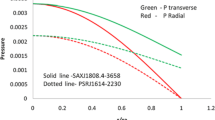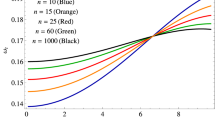Abstract.
In the present article a new generalised solution is obtained for anisotropic matter configuration using Karmarkar’s condition. The solution is used to model the interior structure of anisotropic relativistic objects as it satisfies all necessary physical conditions. The pressure, density and metric potentials are free from any singularities and exhibit well behaved nature inside the anisotropic fluid sphere. The TOV equation is well maintained within the stellar configuration and all energy conditions hold good. The causality condition is well satisfied for our stellar models and stability of compact star models is further verified via Herrera’s cracking method. Harrison-Zeldovich-Novikov criterion for stability is also satisfied by our model. The adiabatic index is greater than \(\frac{4}{3}\) throughout the stellar interior and the compactification factor also lies within the Buchdahl limit i.e.\(M/R \le 4/9\). We investigate the models for two compact stars PSRJ0348+0432 and SAX J1808.4-3658 within the framework of the general theory of relativity. The estimated mass and radius are in close agreement with the observational data. we extensively study the solutions corresponding to compact star PSRJ0348+0432 for \( n = 0, 1, 2, 3, 4, 4.5\) and the detailed graphical analysis is provided to substantiate the viability of the compact star model. One specific feature of our solution is that for large values of n, i.e. for \( n > 5\) solution reduces to Finch and Skea type solution.
Similar content being viewed by others
References
M. Alford, M. Braby, M.W. Paris, S. Reddy, Astrophys. J. 629, 969 (2005)
A. Drago, A. Lavango, G. Pagliara, Phys. Rev. D 89, 043014 (2014)
R. Ruderman, Rev. Astron. Astrophys. 10, 427 (1972)
F. Weber, Pulsars as Astrophysical Observatories for Nuclear and Particle Physics (Institute of Physics, Bristol, 1999)
A.I. Sokolov, J. Exp. Theor. Phys. 79, 1137 (1980)
R.F. Sawyer, Phys. Rev. Lett. 29, 382 (1972)
K.R. Karmarkar, Proc. Indian Acad. Sci. 27, 56 (1948)
S.N. Pandey, S.P. Sharma, Gen. Relativ. Grav. 14, 113 (1981)
K. Schwarzschild, Sitz. Deut. Akad. Wiss. Math. Phys. Berlin 24, 424 (1916)
K.N. Singh et al., Astrophys. Space Sci. 361, 173 (2016b)
K.N. Singh et al., Int. J. Mod. Phys. D 25, 1650099 (2016c)
K.N. Singh, N. Pant, Indian J. Phys. 90, 843 (2016a)
K.N. Singh, N. Pant, Astrophys. Space Sci. 361, 177 (2016b)
R. Sharma, B.S. Ratanpal, arXiv:1307.1439v1 (2013)
M. Malaver, Front. Math. Appl. 1, 9 (2014)
M. Malaver, Int. J. Mod. Phys. Appl. 2, 1 (2015)
F.S.N. Lobo, Class. Quantum Grav. 23, 1525 (2006)
R. Sharma, S.D. Maharaj, Mon. Not. R. Astron. Soc. 375, 1265 (2007)
K. Komathiraj, S.D. Maharaj, Int. J. Mod. Phys. D 16, 1803 (2007)
Piyali Bhar, Muhmmad Hasan Murad, Astrophys. Space Sci. 361, 334 (2016)
Piyali Bhar, Astrophys. Space Sci. 359, 41 (2015)
Rahaman, S. Ray, A.K. Jafry, K. Chakraborty, Phys. Rev. D 82, 104055 (2010)
S. Thirukkanesh, F.C. Ragel, Pramana J. Phys. 78, 687 (2012)
R. Tikekar, V.O. Thomas, Pramana J. Phys. 52, 237 (1999)
R. Tikekar, K. Jotania, Pramana J. Phys. 68, 397 (2007)
K.N. Singh et al., Mod. Phys. Lett. A 32, 1750093 (2017)
S.K. Maurya, Eur. Phys. J. A 53, 89 (2017)
Ksh. Newton Singh, Neeraj Pant, Eur. Phys. J. C 76, 524 (2016)
L. Herrera, Phys. Lett. A 165, 206 (1992)
H. Abreu et al., Class. Quantum Grav. 24, 4631 (2007)
H. Heintzmann, W. Hillebrandt, Astron. Astrophys. 38, 51 (1975)
L. Herrera et al., Astrophys. J. 234, 1094 (1979)
R. Chan et al., Mon. Not. R. Astron. Soc. 265, 533 (1993)
B.K. Harrison, Gravitational Theory and Gravitational Collapse (University of Chicago Press, 1965)
Ya.B. Zeldovich, I.D. Novikov, Relativistic Astrophysics, Vol. 1, Stars and Relativity (University of Chicago Press, 1971)
S. Bhattacharyya, Astron. Astrophys. arXiv:astro-ph/0112175v1 (2001)
T.M. Darias et al., Mon. Not. R. Astron. Soc. 394, L136 (2009)
M.R. Finch, J.E.F. Skea, Class. Quantum Grav. 6, 467 (1989)
L. Herrera, J. Ospino, A. Di Prisco, Phys. Rev. D 77, 027502 (2008)
Author information
Authors and Affiliations
Corresponding author
Additional information
Communicated by L. Tolos
Rights and permissions
About this article
Cite this article
Fuloria, P. A new generalised solution to generate anisotropic compact star models in the Karmarkar space-time manifold. Eur. Phys. J. A 54, 179 (2018). https://doi.org/10.1140/epja/i2018-12615-2
Received:
Accepted:
Published:
DOI: https://doi.org/10.1140/epja/i2018-12615-2




